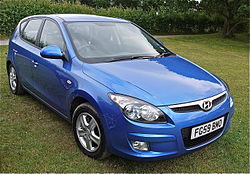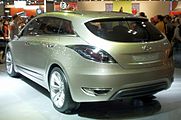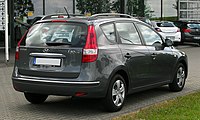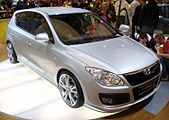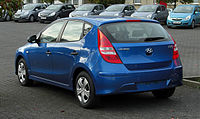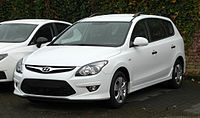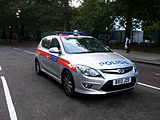Hyundai i30 (FD)
| Hyundai | |
|---|---|
|
Hyundai i30 (2007-2010)
|
|
| i30 / Elantra Touring | |
| Production period: | 2007–2012 |
| Class : | Compact class |
| Body versions : | Station wagon , station wagon |
| Engines: |
Otto engines : 1.4–2.0 liters (80–105 kW) Diesel engines : 1.6–2.0 liters (66–103 kW) |
| Length: | 4250-4475 mm |
| Width: | 1800 mm |
| Height: | 1488-1565 mm |
| Wheelbase : | 2650 mm |
| Empty weight : | 1250-1500 kg |
| Previous model | Hyundai Elantra |
| successor | Hyundai i30 (GD) |
| Stars in the Euro NCAP - Crash Test |
|
The Hyundai i30 is a compact class passenger car from the Korean car manufacturer Hyundai Motor Company . The five-door hatchback sedan was presented at the Geneva Motor Show in March 2007 and came onto the German market in July 2007.
history
In the summer of 2007, Hyundai introduced new names for its vehicles in Europe with the i30. From spring 2008 it was also available as a station wagon under the name i30cw. In autumn 2008 the model was launched in the USA under the name Elantra Touring.
In the manufacturer's model range, it replaced the Elantra mid-range sedan in Europe and is positioned between the Hyundai Accent small car and the Hyundai Sonata mid- range sedan within the model range .
In June 2010 the i30 series received a facelift . Here u. a. the front area retouched and provided with a radiator grille in a hexagonal design, which is already known in a similar way from the ix35 .
At the IAA 2011, Hyundai presented the new edition of the i30 for the first time, which appeared in spring 2012. The i30 (type GD) increased in size and trunk volume. In addition to the technical innovations, knee airbags for the driver, adaptive headlights, instruments with high-resolution TFT-LCD displays and an electric parking brake are integrated as standard.
According to the Federal Motor Transport Authority, the number of models on January 1, 2013 was 134,385.
production
Like the parallel model Kia cee'd, the Hyundai i30 was specially developed for Europe and is designed as a volume model of the brand.
Designed in Hyundai's European design center in Rüsselsheim , it was produced in November 2008 at the Hyundai Motor Manufacturing Czech plant in Nošovice . The units previously imported to Europe came from the production facility at the South Korean Ulsan plant and rolled off the assembly line there in badge engineering together with the Elantra Touring . For other export markets such as Australia, the i30 continued to come from Ulsan.
Around 130,598 Hyundai i30 and i30cw were produced in the Nošovice plant in 2010.
design
| Hyundai | |
|---|---|
| Arnejs Concept | |
| Presentation: | Fall 2006, Paris |
| Body versions : | Hatchback , five-door |
| Engine: | 2.0 l R4 diesel 125 kW (170 PS) |
| Length: | 4335 mm |
| Width: | 1840 mm |
| Height: | 1488 mm |
| Wheelbase: | 2649 mm |
| Circuit: | 5-stage automatic |
Studies
The basis for the final design of the five-door sedan and the other versions were the studies Hyundai Arnejs (presented at the Paris Motor Show 2006) and Hyundai Genus , from which the series versions were derived.
HED-3 Arnejs
The ice-blue painted, compact vehicle has LED lights all around and 19-inch chrome rims. Turquoise brake calipers, four individual seats made of light and brown leather and nonexistent B and C pillars with completely retractable side windows characterize the study. A special highlight is a glass roof, which tapers directly from the windshield to the rear to the tailgate.
HED-2 genus
The space concept of the study is a crossover model that combines the advantages of a sporty station wagon with those of a van . A special feature of the Genus is its extendable rear lower part like the FlexFix on the current Opel Corsa , which can be used as a bike rack. The interior offers beige-brown leather for four individual seats, deep-pile carpets and a generous use of aluminum decor. Outside, there is a light edge above the door handles, a bronze-colored metallic paint and a double exhaust. Instead of conventional exterior mirrors, cameras are equipped with LED indicators; the front and fog lights as well as the rear lights are also made with LED technology. A large panoramic glass roof, nonexistent C-pillars and frameless panes should ensure a light-flooded interior.
A key design element is a concave D-pillar, which gives the car a high recognition value . With the genus, the new hexagon front section was shown for the first time as a new identity feature for the upcoming Hyundai vehicle generations in Europe. The study stands on 7-spoke 19-inch rims made of aluminum and chrome. The vehicle was completely developed in the Rüsselsheim design center. The lead designers in the team of chief designer Thomas Bürkle were the exterior designer Thomas Sälzle and the interior designer Eduardo Marchena.
The genus is the inspiration for the i40cw launched in summer 2011 .
series
limousine
Some elements of the two studies were adopted for the production version. With a more modern and dynamic appearance and a related departure from the cheap Korean image, Hyundai promised a significant increase in sales. The i30 and its sister model, the Kia cee'd, not only share the technology, but are also similar externally in terms of dimensions and looks.
Station wagon
At the beginning of April 2008, like the Kia cee'd SW, a station wagon version was added, which Hyundai provided with the additional designation "cw". This also stands for “Crossover Wagon” on other models of the brand (such as the i40cw). In Great Britain it is also known as the "i30 Estate ". Overall, the "i30cw" was 4.48 meters long and towered over the sedan by 23 centimeters. The station wagon shared the front design with the sedan, but the rear lights were higher up. The trunk volume was 415 to 1395 liters.
Facelift
In June 2010 the i30 was given a facelift . The front section was revised and the radiator grille was installed in a hexagonal design. Furthermore, the design of the rear apron has been revised.
In Germany, along with the revision, the various equipment variants were upgraded and the vehicle warranty was extended from three to five years:
- The Classic had fog lights, a gearshift indicator and a redesigned gear knob for the gearbox as standard.
- The Comfort also had electrically folding exterior mirrors, automatic air conditioning, a rear center armrest with cup holders and a coming home function.
- The style had a cruise control system, a reversing warning system, a rain sensor and a windshield wiper de-icer.
- The Premium variant was deleted because its product properties were now incorporated into the other equipment variants .
i30 as a police vehicle for the Metropolitan Police Service
technology
The car, developed under the internal abbreviation FD and initially built in Korea, shares the floor pan and the technical base with the Kia cee'd, which appeared in January 2007 . Both vehicles are now from the same production line in Nošovice ( Czech Republic ) and also have the same engines. The abbreviation has since been changed to FDH , which is particularly important for accessories: parts approved for the i30 type FD must therefore not automatically be used for the i30 type FDH .
Engines and gears
All engines drive the front wheels , are installed transversely at the front and have traction control that prevents the drive wheels from spinning. It is part of the standard ESP . The four-cylinder engines have 16 valves and an aluminum cylinder head. All engines met the Euro 4 emissions standard , the petrol and diesel with 1.4-1.6 l displacement since 08/2010 Euro 5. At this point in time, the 2.0 l engines were taken out of the range because they - from coming from older series - do not meet the Euro 5 standard that will become mandatory from January 2011. All current engines are also available with an automatic start-stop system ( Idle Stop & Go, ISG ) as the i30 Blue, which reduces fuel consumption.
| Petrol engines | ||||||
|---|---|---|---|---|---|---|
| model | Displacement | cylinder | power | Torque | transmission | construction time |
| 1.4 l | 1396 cc | R4 | 80 kW (109 PS) / 6200 | 137 Nm at 5000 rpm | 5-speed manual transmission | 08/2007–06/2012 |
| 1.6 l | 1591 cc | R4 | 90 kW (122 PS) / 6200 | 154 Nm at 4200 rpm | 5-speed manual transmission | 08 / 2007-06 / 2010 |
| 1.6 l | 1591 cc | R4 | 93 kW (126 PS) / 6200 | 154 Nm at 4200 rpm | 5-speed manual transmission / 4- speed automatic transmission | 08/2008 - 06/2012 |
| 2.0 l | 1975 cc | R4 | 105 kW (143 PS) / 6000 | 186 Nm at 4600 rpm | 5-speed manual transmission / 4- speed automatic transmission | 08 / 2007–07 / 2010 |
| Diesel engines | ||||||
| 1.6 l CRDi | 1582 cc | R4 | 66 kW (90 PS) / 4000 | 235 Nm at 1750-2500 rpm | 5-speed manual transmission / 6-speed manual transmission | 08/2008 - 06/2012 |
| 1.6 l CRDi | 1582 cc | R4 | 85 kW (116 PS) / 4000 | 255 Nm at 1900-2750 rpm | 5-speed manual transmission / 4- speed automatic transmission | 08/2007–06/2012 |
| 1.6 l CRDi | 1582 cc | R4 | 94 kW (128 PS) / 4000 | 260 Nm at 1900-2750 rpm | 6-speed manual transmission | 07 / 2009-06 / 2012 (not in Germany) |
| 2.0 l CRDi | 1991 cc | R4 | 103 kW (140 PS) / 3800 | 305 Nm at 1800-2500 rpm | 6-speed manual transmission | 08 / 2007-09 / 2010 |
CRDi : Hyundai abbreviation for Common Rail Diesel
Steering, chassis and brakes
A speed-dependent servo-assisted rack-and-pinion steering was installed in all versions . The 90 kW motor had an electric servo, the others had an electro-hydraulic one.
All the wheels were individually suspended: in the front on wishbones, MacPherson struts with gas pressure shock absorbers and stabilizers, behind on a multi-link axle .
The dual-circuit brake system worked with disc brakes on all four wheels (also internally ventilated at the front) and a brake booster ("servo brake").
Equipment (03/2007 to 06/2010)
The i30 was offered in Germany from March 2007 to June 2010 in four different equipment variants: Classic , Comfort , Style and Premium .
The Premium equipment variant was deleted as part of the model update carried out in mid-2010 and its equipment features were integrated into the equipment below. List prices started at € 15,140 for the i30 1.4 Classic and staggered up to € 24,250 for the i30 2.0 CRDi Premium .
The Hyundai offered six airbags , ABS , ESP , an on-board computer , an MP3-compatible CD radio with USB and AUX connection, power windows at the front and central locking as standard in all equipment . With corresponding higher equipment variants, additional extras were added that were not offered individually or as a separate package. So was z. For example, seat heating is only available in conjunction with the Style or Premium equipment variant, with additional extras that were included in these variants. In addition to the equipment variant, only the paintwork was freely selectable by the customer. In addition, Hyundai offered accessories for subsequent installation, such as B. Parking aids, alloy wheels and navigation devices.
- Full-size driver or front passenger airbag with gentle pressure build-up
- Passenger airbag can be deactivated
- Side airbags in front for chest and head
- Curtain airbags reaching into the rear
- active headrests in front
- Anti-lock braking system (ABS) + electr. Brake force distribution (EBV)
- automatic door unlocking in the event of an accident
- double side impact protection in the doors
- Three-point belt system on all seats
- Third Stoplight
- electronic immobilizer
- Energy-absorbing safety body
- ESP with integrated brake assist
- Belt tensioners and belt force limiters at the front
- height-adjustable headrests on all seats
- height-adjustable seat belts in front
- integrated support ramp on all seats
- Isofi-x child seat attachment on the back of the outer seats
- Clear glass optics halogen headlights with automatic light off
- Rear disc brakes
- Front disc brakes (internally ventilated)
- Seat occupancy detection on all seats
- Insulation of the bonnet
- tinted windows all around
- Rear window wiper and washer system (with interval)
- heated rear window with timer
- Protective strips painted in body color (front and rear)
- Storage options in the front center console
- Storage options in the doors
- Glove box (illuminated)
- integrated CD radio with MP3 function
- Connections for USB, AUX (e.g. iPod)
- Antenna on the back of the roof
- On-board computer with range display
- On-board computer with trip odometer
- On-board computer with average consumption display
- Outside temperature display
- Attachment hooks in the trunk
- Digital clock
- electrically assisted power steering
- coolable glove compartment
- Luggage compartment cover
- Luggage compartment lighting
- Cup holder in the center console (twice)
- Grab handle for front and rear passengers
- Interior lighting
- Cosmetic mirror in the sun visor with cover
- Remote tank flap unlocking
- Central locking including trunk opening
- Height-adjustable driver's seat
- Rear seat backrest split 60:40, foldable
| Classic | Comfort | Style | Premium | |
|---|---|---|---|---|
| Alarm system | - | • | • | • |
| Light sensor | - | - | • | • |
| Fog lights | - | • | • | • |
| rain sensor | - | - | - | • |
| Tire pressure control system | - | - | • | • |
| Safety steering column adjustable in angle | • | - | - | - |
| Safety steering column adjustable for inclination and length | - | • | • | • |
| Spherical exterior mirrors on the driver's side | - | • | • | • |
| Exterior mirrors, heated | - | • | • | • |
| Electrically adjustable exterior mirrors | - | • | • | • |
| Exterior mirrors painted in body color | - | • | • | • |
| Electrically foldable exterior mirrors | - | • | • | • |
| Hub caps | • | • | - | - |
| Alloy wheels | optional | optional | • | • |
| Door handles in black | • | - | - | - |
| Door handles painted in body color | - | • | • | • |
| Storage option in the front center armrest | - | • | • | • |
| Storage pockets on the back of the front seats | - | • | • | • |
| Remote control of the audio system via the steering wheel | - | • | • | • |
| 4 speakers | • | - | - | - |
| 6 loudspeakers incl. 2 tweeters | - | • | • | • |
| Illuminated ignition lock | - | • | • | • |
| Electric windows in front | • | - | - | - |
| Electric windows front and rear | - | • | • | • |
| Radio remote control for central locking | - | • | • | • |
| Luggage net in the trunk | - | • | • | • |
| Cruise control can be operated via the steering wheel | - | - | - | • |
| Cup holder in the rear center armrest | - | - | - | • |
| Map reading lamp in front | - | • | • | • |
| Air conditioning / automatic climate control | • / - | - / • | - / • | - / • |
| Reversing warning system | - | - | - | • |
| Windshield wiper de-icer | - | - | - | • |
| Chromed door handles inside | - | • | • | • |
| Seats in fabric | • | • | - | - |
| Seats in a combination of fabric and leather | - | - | • | - |
| Seats in leather | - | - | - | • |
| Driver's seat with adjustable lumbar support | - | • | • | • |
| Seat heating | - | - | • | • |
Equipment (from 06/2010)
With the facelift in June 2010, the equipment variants changed slightly. The changes affected the following equipment features:
| Classic | Comfort | Style | |
|---|---|---|---|
| Fog lights | • | • | • |
| Switching point display | • | • | • |
| electrically folding exterior mirrors | - | • | • |
| Automatic climate control | - | • | • |
| Rear center armrest with cup holder | - | • | • |
| Coming home function | - | • | • |
| Cruise control system | - | optional | • |
| Reversing warning system | - | optional | • |
| rain sensor | - | - | • |
| Windshield wiper de-icer | - | - | • |
Furthermore, Hyundai had introduced two additional packages. The trend package for the Classic equipment variant and the Plus package for the Comfort equipment variant . The trend package costs EUR 690 and the plus package costs EUR 850. The equipment variant Premium has been deleted and its equipment features have been integrated into the lower equipment variants.
Trend package:
- Inclination and length adjustable safety steering column
- electrically adjustable and heated exterior mirrors in body color
- Radio remote control for the central locking
- Reading lights for the front
- Tweeter for the radio
- Seat heating for the front
Plus package:
- Leather steering wheel / gear knob
- Light sensor
- rain sensor
- Windshield wiper de-icer
- automatically dimming interior mirror
EU imports
The EU imports available in Germany often differed in terms of standard equipment from the vehicles offered in Germany, although some of them had the same names. In particular, the ESP was often missing in the basic variant.
Exterior paintwork
In addition to the free plain paints, there are a number of different, optional metallic paints and paints with a mineral effect.
| Crystal White Uni |
Shine Red 1 Uni |
|||||
| Continental Silver Metallic |
Champagne Silver Metallic |
Steel Gray Metallic |
Vivid Blue 1 Metallic |
Moonlight Blue 1 Metallic |
||
| Glowing Red mineral effect |
Cashmere Brown mineral effect |
Ice blue mineral effect |
Indigo blue mineral effect |
Stone black mineral effect |
Phantom Black mineral effect |
Ember Red 1 mineral effect |
1 color is no longer available.
safety
In the Euro NCAP crash test (2007), the Hyundai i30 received 33 points (12 in the front, 16 in the side crash, two in the pole test and three points for the seat belt warning system), a four-star rating for adult occupant protection, a three Star rating (out of five) for child protection and two out of four stars for pedestrian safety. So the i30 just missed the result of the Kia cee'd .
Hard structures behind the dashboard led to the downgrading of occupant protection (only four stars instead of five) , which can result in increased loads on the legs of the front occupants. Therefore, the Hyundai i30 did not achieve the minimum score of 13 points required for a five-star rating in a frontal crash.
As a result, Hyundai revised the i30 in the lower area of the dashboard in order to reduce the stress on the knees and achieve a better rating in a frontal crash. In the second crash test in 2008, the Hyundai i30 achieved 34 out of 37 points and thus a five-star rating for occupant protection. Child protection also improved by one star to four out of five stars. The pedestrian protection rating remained the same with two out of four stars. The Hyundai i30 is now level with the Kia cee'd .
The crash test result of the Hyundai i30 is the best so far of a Hyundai in the Euro NCAP crash test.
New registrations
New registrations in Germany since market launch:
| year | New registrations |
|---|---|
| 2007 | 3,645 |
| 2008 | 9,487 |
| 2009 | 27,994 |
| 2010 | 30.501 |
| 2011 | 32,697 |
| 2012 | 28 789 * |
* from April 2012 with successor model Hyundai i30 (GD)
New registrations in Austria from May 2008:
| year | New registrations |
|---|---|
| 2008 | 1,018 (May to Dec.) |
| 2009 | 3,978 |
| 2010 | 8,017 |
| 2011 | 6,270 |
| 2012 | 3,569 (Jan-June) |
Enrollment in Switzerland:
| year | Matriculations |
|---|---|
| 2007 | 708 |
| 2008 | 1,959 |
| 2009 | 1,654 |
| 2010 | 1,770 |
| 2011 | 2,417 |
Awards
The Hyundai i30 1.4 Edition Plus was Value Champion 2010 in the compact class . In the calculation of the most stable vehicles carried out by Auto Bild and EurotaxSchwacke , he achieved the “lowest loss in value in euros”. In four years, the model lost only 6686 EUR in value. The Hyundai i30 1.4 Edition Plus also achieved the lowest loss of value in the forecast from bähr & fess forecasts up to 2014 and 2015 commissioned by Focus Online.
In Australia, the i30 was named the best mid-range car under $ 30,000 in 2008 and 2009. In 2010, Australia's largest automobile club, National Roads and Motorists' Association Limited (NRMA), awarded the Hyundai i30 SX the lowest cost of ownership in the Small class.
Also in 2008 the Hyundai i30 was voted “Car of the Year” in Spain.
In Great Britain, over 23,000 readers of Auto Express magazine (an offshoot of Auto Bild) voted the i30 as the most reliable car of 2010 in the “Driver Power Top 100”.
Web links
- Official website ( Memento of February 13, 2009 in the Internet Archive )
Individual evidence
- ↑ Crash test Hyundai i30 (2008)
- ↑ http://www.newcartestdrive.com/sneakpreview.cfm?ReviewID=190
- ↑ google.com/hostednews ( Memento from January 24, 2013 in the web archive archive.today )
- ↑ http://www.autobild.de/artikel/hitliste-der-meistverkauften-autos-2009-1036259.html
- ↑ http://www.autosieger.de/article20959.html
- ↑ http://www.autogenau.de/news/aktuelles/hyundai-haendler-bauen-ihren-marktkauf-auf-255-prozent-aus.html
- ↑ http://www.autogenau.de/news/aktuelles/hyundai-zulassungen-maerz-2011.html
- ↑ http://www.autogenau.de/news/aktuelles/hyundai-waechst-zur-drittstaerksten-importmarke-deutschlands.html
- ↑ http://www.auto.at/contator/autobiz/zulassungen2.asp?mo=Hyundai+I30
- ↑ http://www.statistik.at/web_de/static/kfz-neuzulassungen_jaenner_bis_dezember_2010_043546.pdf
- ↑ Page no longer available , search in web archives:
- ↑ Archive link ( Memento of the original from February 10, 2013 in the Internet Archive ) Info: The archive link was inserted automatically and has not yet been checked. Please check the original and archive link according to the instructions and then remove this notice.
- ↑ http://www.hyundai.de/pages/kundenservice/garantie/autobildreport.html?sid=85e40458433215e7e42526e0c365f336 ( page no longer available , search in web archives ) Info: The link was automatically marked as defective. Please check the link according to the instructions and then remove this notice.
- ↑ Archive link ( Memento of the original from August 27, 2010 in the Internet Archive ) Info: The archive link was inserted automatically and has not yet been checked. Please check the original and archive link according to the instructions and then remove this notice.
- ↑ Gerd Stegmaier, Bernhard Santer: Compact. In: Focus Online . October 18, 2010, accessed October 14, 2018 .
- ↑ Gerd Stegmaier, Bernhard Santer: compact car. In: Focus Online . April 18, 2011, accessed October 14, 2018 .
- ↑ http://www.pressportal.com.au/news/206/ARTICLE/5386/2010-08-12.html
- ↑ Archive link ( Memento of the original from August 15, 2010 in the Internet Archive ) Info: The archive link was inserted automatically and has not yet been checked. Please check the original and archive link according to the instructions and then remove this notice.
- ↑ Hyundai i30 is 2008 Car of the Year in Spain ( Memento of the original from September 9, 2012 in the web archive archive.today ) Info: The archive link was inserted automatically and has not yet been checked. Please check the original and archive link according to the instructions and then remove this notice. January 29, 2008
- ^ Hyundai Ireland The Hyundai i30 Wins Car of the Year 2008 Award in Spain . Hyundai.ie. Archived from the original on July 21, 2011. Info: The archive link was inserted automatically and has not yet been checked. Please check the original and archive link according to the instructions and then remove this notice. Retrieved October 14, 2009.
- ^ The Public Has Voted - Hyundai's i30 Is The Most Satisfying Car In Britain April 14, 2010. The Auto Channel
- ^ Hyundai is the most satisfying car 11 Apr 2010. Telegraph
